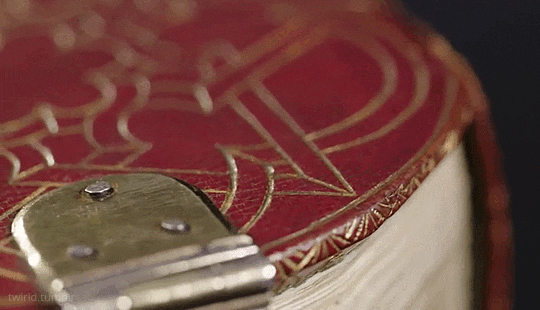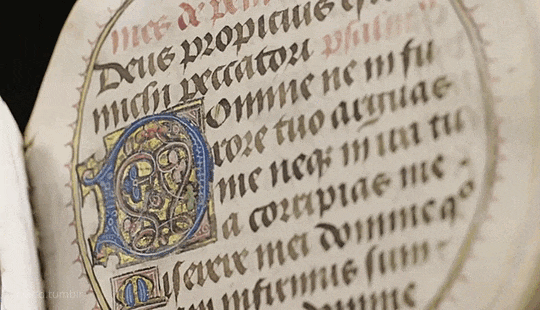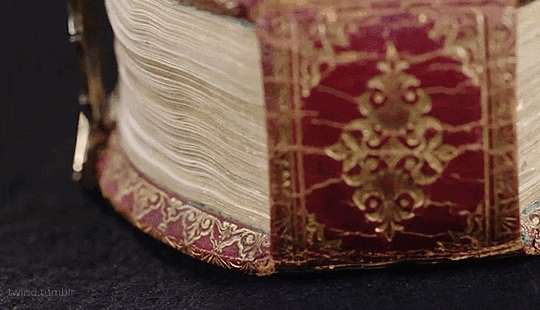Codex Rotundus “266 Almost Perfectly Circular Pages Of Parchment Have Been Bound Together To Build





Codex Rotundus “266 almost perfectly circular pages of parchment have been bound together to build a block of 3cm height with a diameter of only 9cm.”
The initials of the metal clasps point us to Adolph of Cleves, Lord of Ravenstein (1425 - 1492) as the owner.
More Posts from Automastigwma and Others

Ruined Monastery of Eldena near Greifswald by Caspar David Friedrich



Claude Paradin, Devises Heroïques, 1567

Fred Appleyard (British, 1874-1963) St Cecilia, exhibited 1903

La visión del Coloseo. El último mártir
“I’m not sure which is worse: intense feeling, or the absence of it.”
— Margaret Atwood, The Blind Assassin
One of my favorite historical tidbits is that Arab traders, for centuries, fooled Europeans into thinking cinnamon came from a rare, vicious and fearsome cinnamon bird.
The belief was so prevalent, in fact, that the mythical cinnamon bird shows up in the writings of Herodotus and Aristotle, all the way into medieval European manuscripts where it’s illustrated in all its fierce, cinnamony glory:


Pliny the Elder expressed skepticism of the bird in his writings, rightly assuming that it was a tale invented to keep control on the trade and prices by reducing competition, but the belief was already so widespread that it persisted in many areas into the early 1300’s.

Winter Full Moon Night over the Ruins of a Gothic Chapel (Felix Kreutzer, 1835 - 1876)

Circa mid-1500’s


Bronze helmet, Crete, 630-600 BC
from The Heraklion Museum




Темные духи Алтая. Фотограф Кулакова Екатерина. Россия (Санкт-Петербург).
Dark spirits of Altai. Photographer Ekaterina Kulakova. Russia (Saint Petersburg).
Источник:/35photo.pro/diamanda/profile, /35photo.pro/photo_ 4631100/#author/4631100.
-
 zvixs reblogged this · 1 week ago
zvixs reblogged this · 1 week ago -
 lilspinter reblogged this · 1 week ago
lilspinter reblogged this · 1 week ago -
 chaoticseaspell liked this · 1 week ago
chaoticseaspell liked this · 1 week ago -
 thenorthernwindsblog reblogged this · 1 week ago
thenorthernwindsblog reblogged this · 1 week ago -
 interrobangprotectionsquad reblogged this · 1 week ago
interrobangprotectionsquad reblogged this · 1 week ago -
 randi2204 reblogged this · 1 week ago
randi2204 reblogged this · 1 week ago -
 kouryuudielysion reblogged this · 1 week ago
kouryuudielysion reblogged this · 1 week ago -
 positivewitch liked this · 1 week ago
positivewitch liked this · 1 week ago -
 unlikelypersonalknight1 reblogged this · 1 week ago
unlikelypersonalknight1 reblogged this · 1 week ago -
 unlikelypersonalknight1 liked this · 1 week ago
unlikelypersonalknight1 liked this · 1 week ago -
 elenasphotoblog reblogged this · 1 week ago
elenasphotoblog reblogged this · 1 week ago -
 crystalthevampirate liked this · 1 week ago
crystalthevampirate liked this · 1 week ago -
 befuddledmackem reblogged this · 2 weeks ago
befuddledmackem reblogged this · 2 weeks ago -
 witchweedz liked this · 2 weeks ago
witchweedz liked this · 2 weeks ago -
 bigmilkshakerebel liked this · 2 weeks ago
bigmilkshakerebel liked this · 2 weeks ago -
 sweetessenseoasis reblogged this · 2 weeks ago
sweetessenseoasis reblogged this · 2 weeks ago -
 kingkrabby liked this · 2 weeks ago
kingkrabby liked this · 2 weeks ago -
 mistbunny liked this · 2 weeks ago
mistbunny liked this · 2 weeks ago -
 fussblush reblogged this · 2 weeks ago
fussblush reblogged this · 2 weeks ago -
 mothereart liked this · 2 weeks ago
mothereart liked this · 2 weeks ago -
 tropicaldream29 reblogged this · 2 weeks ago
tropicaldream29 reblogged this · 2 weeks ago -
 thoughtcontainment liked this · 2 weeks ago
thoughtcontainment liked this · 2 weeks ago -
 flpamb liked this · 2 weeks ago
flpamb liked this · 2 weeks ago -
 crossedsardines reblogged this · 2 weeks ago
crossedsardines reblogged this · 2 weeks ago -
 crossedsardines liked this · 2 weeks ago
crossedsardines liked this · 2 weeks ago -
 devilishangellll reblogged this · 2 weeks ago
devilishangellll reblogged this · 2 weeks ago -
 mysticallion liked this · 2 weeks ago
mysticallion liked this · 2 weeks ago -
 dgalga reblogged this · 2 weeks ago
dgalga reblogged this · 2 weeks ago -
 jesusmartin reblogged this · 2 weeks ago
jesusmartin reblogged this · 2 weeks ago -
 jesusmartin liked this · 2 weeks ago
jesusmartin liked this · 2 weeks ago -
 wallbike reblogged this · 2 weeks ago
wallbike reblogged this · 2 weeks ago -
 fabulous-cookware252 liked this · 2 weeks ago
fabulous-cookware252 liked this · 2 weeks ago -
 ariwhat reblogged this · 2 weeks ago
ariwhat reblogged this · 2 weeks ago -
 ariwhat liked this · 2 weeks ago
ariwhat liked this · 2 weeks ago -
 lalulutres reblogged this · 2 weeks ago
lalulutres reblogged this · 2 weeks ago -
 lalulutres liked this · 2 weeks ago
lalulutres liked this · 2 weeks ago -
 caramelcalamity reblogged this · 2 weeks ago
caramelcalamity reblogged this · 2 weeks ago -
 daisies-in-thedark liked this · 2 weeks ago
daisies-in-thedark liked this · 2 weeks ago -
 balancingitall liked this · 2 weeks ago
balancingitall liked this · 2 weeks ago -
 trerunor liked this · 2 weeks ago
trerunor liked this · 2 weeks ago -
 changogrande liked this · 2 weeks ago
changogrande liked this · 2 weeks ago -
 peer-otto liked this · 2 weeks ago
peer-otto liked this · 2 weeks ago -
 thevisualmachine reblogged this · 2 weeks ago
thevisualmachine reblogged this · 2 weeks ago -
 furthestfromthetruth reblogged this · 2 weeks ago
furthestfromthetruth reblogged this · 2 weeks ago -
 cursed-ziki liked this · 2 weeks ago
cursed-ziki liked this · 2 weeks ago -
 originallandlockedmariner reblogged this · 2 weeks ago
originallandlockedmariner reblogged this · 2 weeks ago

134 posts